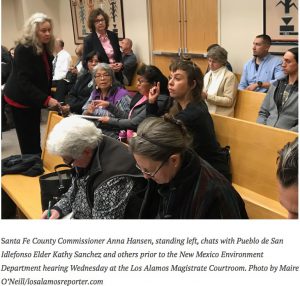
BY MAIRE O’NEILL thelosalamosreporter.com
A public hearing being conducted by the New Mexico Environment to consider the ground water discharge permit for Los Alamos National Laboratory headed into its second day Thursday in the Los Alamos Magistrate Courtroom.
On Wednesday, public comment was heard throughout the day from members of the public, tribal representatives, public officials and watchdog groups such as Nuclear Watch New Mexico.
Santa Fe County Commissioner Anna Hansen said she has in the past and continues to support the persistence of Communities for Clean Water to ensure that the NMED hearing is taking place. She said many Santa Fe County residents work at or near LANL and that Santa Fe County share the water resources. She said the permit needs to be modified to require more robust sampling, monitoring and reporting.
“More reporting will inform local government, the public and the media about the progress of LANL to address the three plumes that are moving towards the Rio Grande,” she said.
Hansen said a website should be created similar to that established for the Environmental Protection Agency which would provide updated information, notice of opportunities to provide public comments, the posting of documents submitted to NMED and the agency’s response.
“The permit needs to be modified to require the most protective standards for public health for all potential contaminates,” she said.
Scott Kovac, Operations and Research Director for Nuclear Watch New Mexico said the final remedy for the chromium project has not yet been decided so the need for land application has not yet been proven necessary.
“The permit requires a detailed description of the proposed activity including a statement of purpose prior to initiating discharge. We request that this statement of purpose include a statement of need since the actual amount of chromium in the plume is unknown. This land application proposal would end up bringing much chromium to the surface and dispersing it to the environment,” he said.
Kovac said he was concerned the land application proposal could end up being the primary method to remove chromium from the aquifer without proper analysis. He said he is concerned about the different ways the proposal is described. He asked for clarification as to whether the term “groundwater remediation activities” is the same as “treated groundwater derived from individual projects including the chromium project” and if all the water in this land application process would only come from the chromium project.
“The permit must require that all workplans have more robust monitoring, including requirements for baseline data collection, mass loading monitoring and comprehensive soil and water monitoring throughout the permit term instead of only once at the end of the permit,” Kovac said.
He asked if the quick paths to the vadose zones or to the regional aquifer have been studied and if there are any faults in the 55 sections proposed for the land application. He slaos asked what the travel time is to the vadose zone in the regional aquifer from each section.
Jay Coghlan, Executive Director of Nuclear Watch said he wanted to explain why he generally has a very dim view of cleanup at LANL.
“For starters, approximately $2 billion has been spent to date since the 1990s and in my opinion not that much has been done in terms of cleanup. The Laboratory, and the DOE explicitly, plans to spend up to another $4 billion over the next 40 years. But to explicitly leave some 200,000 cubic meters of radioactive and toxic waste sitting in the dumps here on top of our aquifer, in my view this is essentially cleanup on the cheap so that the Laboratory can go on with its main goal of expanding plutonium pit production for more nuclear weapons which caused the mess to begin with,” Coghlan said.
He said he is starting to be embarrassed about how long he has been dealing with cleanup issues.
“I’ll harken back to 1996 and I don’t think the public is aware of this, but the Laboratory used to claim in public meetings and it was specifically Charlie Nylander who was head of Los Alamos’s groundwater monitoring program at the time – that groundwater contamination was impossible. And the claim was that the volcanic tuff was impermeable, that that’s why contamination was impossible,” Coghlan said. “But the obvious was overlooked. The Pajarito Plateau is one of the most complex geological areas in the United States. It’s highly fractured and the Laboratory went so far as to formally request a waiver from even having to monitor groundwater contamination which fortunately the New Mexico Environment Department rejected. In the worst case scenario had that been approved we wouldn’t even know what we’re talking about right now. The issue – which is groundwater contamination by chromium. To me this is just incredible.”
Rachel Conn of Amigos Bravos discussed the importance of acknowledging the history of the land at LANL and the importance of being awareness that it is indigenous and ancestral homeland that are being walked on and that the effects of the LANL work are affecting communities downstream. She said bioremediation should be considered for chromium and sitewide. She said it should not be the responsibility of the public to demonstrate the harm being caused.
Throughout the day, speakers addressed many of the same concerns including the need for LANL and NMED to make information more easily accessible and available faster to the public and that the information provide must be complete and accurate. Several speakers asked that LANL and N3B consider bioremediation and holistic remedies for the plume.
Check back with the Los Alamos Reporter for updates on the second day of the public hearing.
